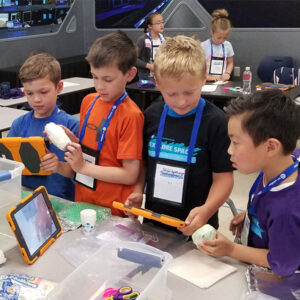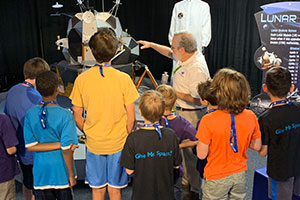STEAM stands for science, technology, engineering, arts and mathematics. The “arts” in STEAM refers not only to visual arts and design but also to language arts, humanities, music, drama, dance and media.
STEAM is more than just a buzzword or a tack-on to STEM. It’s an educational model that builds the creative problem-solving and critical thinking skills students will need in the 21st Century workforce. It may also be one of the keys to solving humanity’s biggest challenges in the years to come.
What is STEAM education?

STEAM education is a holistic, interdisciplinary approach to learning that combines science, technology, engineering, arts and mathematics. It harnesses the natural symbiosis between these disciplines to foster creative problem-solving, collaboration and critical thinking.
“To develop a complete mind: Study the science of art; Study the art of science. Learn how to see. Realize that everything connects to everything else.” — Leonardo Da Vinci
Students use creative processes and multiple methods of inquiry and investigation in STEAM projects, helping them develop a range of hard and soft skills. STEAM lessons should integrate at least two standards and assessments from among the five disciplines.
What is STEM education versus STEAM education?
STEM stands for science, technology, engineering and mathematics, while STEAM adds “arts.” However, the difference between STEM and STEAM is far greater than tacking on another letter or even adding design skills to STEM. While STEM expressly focuses on scientific concepts, STEAM builds on these concepts through the creative process. Students engage both the right (creative) and left (logical) sides of the brain to innovate and solve problems.
The Rhode Island School of Design (RISD)—the birthplace of the modern STEAM educational movement—says it best: “The goal of STEAM is to foster the true innovation that comes with combining the mind of a scientist or technologist with that of an artist or designer.”
Why is STEAM education important?
1. Our future relies on new solutions to help people and planet.
As humanity faces increasing change, challenges and complexity, we need people with the ability to ask the right questions and find new solutions. STEAM—with its focus on not only the “how” and “what” but also the “who” and “why”—is specifically designed to develop future innovators. It encourages students to approach real-world scientific problems with consideration for their impact on humanity.
STEAM is at its heart about innovation, and innovation is about more than developing the latest gadget. Innovation is one of the keys to solving the most pressing problems of our time and ensuring a healthy, sustainable future. To name only a few recent examples:
- Battery technology first developed for cars is now being deployed to store renewable energy
- High-tech hydroponic greenhouses are helping grow food efficiently in urban areas, improving access to healthy food while reducing carbon emissions and costs
- Scientists and conservationists are using new space-based technologies and deep learning to monitor endangered wildlife populations
- Multiple technologies developed for space exploration or research are now used to improve life on Earth
- A commercial satellite venture set to orbit this year promises the most comprehensive data from space to better predict weather and give scientists a clearer picture of global warming
STEAM education is critical to ensure future generations have the skills to carry on and build upon this innovative work.
2. STEAM education prepares students for an ever-changing workforce.
As we enter a new industrial revolution, educators must prepare students for many jobs that don’t even exist yet. Automation will gradually take over repetitive tasks (up to 30% of tasks in 60% of jobs as per McKinsey & Company), but there is no substitute for human ingenuity and creativity. Humans will need to take on jobs that require creativity, critical thinking and the ability to solve novel problems—the core foundational skills addressed by STEAM. Technologies will give rise to new positions for human workers with skill sets to leverage big data, AI, machine learning and more. There will be greater demand for augmenting and enhancing human capabilities in both soft and hard skills.
3. STEAM engages students in learning.
 Many students have greater aptitude and affinity for either arts and humanities or mathematics and science. STEAM education, with its integrated and holistic approach, helps students conceptualize these disciplines as parts of a greater whole. Rather than feeling alienated or tuned out of certain subjects, they can collaborate with others to solve problems and see subjects they struggle with in a different way.
Many students have greater aptitude and affinity for either arts and humanities or mathematics and science. STEAM education, with its integrated and holistic approach, helps students conceptualize these disciplines as parts of a greater whole. Rather than feeling alienated or tuned out of certain subjects, they can collaborate with others to solve problems and see subjects they struggle with in a different way.
STEAM also taps into children’s natural curiosity and creativity. If you’ve ever tried to find answers to a long series of questions asked by a child, you know how inquisitive they are about the world around them! STEAM lessons focus on deep questioning and finding novel solutions rather than memorizing standard facts and figures that can easily be “Googled.”
While STEAM education is still relatively new compared to STEM, there are recent studies that show promising results, including improved scientific creativity, conceptual understanding and science achievement.
Looking for STEAM education resources?
Space Foundation’s Center for Innovation and Education offers a range of space-inspired STEAM educational resources and programs. These include:
- K–12 project-based curriculum and STEAM lesson plans
- Girls in Space Program
- Junior Space Entrepreneur Program
- Space camps
- Professional teacher training
- Space Foundation Discovery Center field trips (virtual and in-person)
- Space in the Community
- “Small Steps, Giant Leap” monthly virtual STEAM program for pre-K and kindergarten learners
You’ll find all of these and more on our Programs for Teachers and Students pages. Happy teaching and learning!